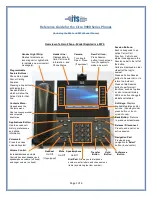
PRELIMINARY: TR-FFT Fire Fighter’s Telephone Manual — LS10309-001TR-E:A 04/28/2021
11
Wiring Specifications
Prerequisites for Installation
2.5 Wiring Specifications
Induced noise (such as, the transfer of the electrical energy from one wire to another wire) can interfere with the telephone
communication or cause false alarms. To avoid the induced noise, follow these guidelines:
•
Isolate the input wiring from the high current output and the power wiring. Do not pull one multi-conductor cable for the
entire panel. Instead, separate the wiring as follows:
•
Do not pull the wires from the different groups through the same conduit. If you must run them together, do so for as short
a distance as possible or use the shielded cable. Twisted, shielded wire on the audio circuits is recommended for the
maximum protection against EMI and AFI emissions and susceptibility. Connect the shield to the Earth Ground at the
panel. You must route the high and the low voltages separately.
•
Route the wiring around the inside perimeter of the cabinet. It should not cross the circuit board, where it could induce
noise into the sensitive microelectronics or pick-up unwanted RF noise from the high speed circuits. See Figure 2.5 on
page 11 for an example.
•
High frequency noise, such as that produced by the inductive reactance of a speaker or bell, can also be reduced by
running the wire through the ferrite shield beads or by wrapping it around a ferrite toroid.
2.6 Wire Routing
You must follow the power-limited wiring techniques, which include maintaining a one-quarter inch spacing between the
power-limited and the non-power limited circuits and separating the high and the low voltage circuits.
.
Figure 2.5 Wire Routing Example
SLC loops
Audio circuits
Relay circuit
Table 2.3 Wiring Specifications
Non-Power-limited Relay Circuit
Power-Limited
Non power-limited wiring
must be run separately from
power-limited wiring.
Summary of Contents for TR-FFT
Page 33: ...Cut Along the Dotted Line ...












































